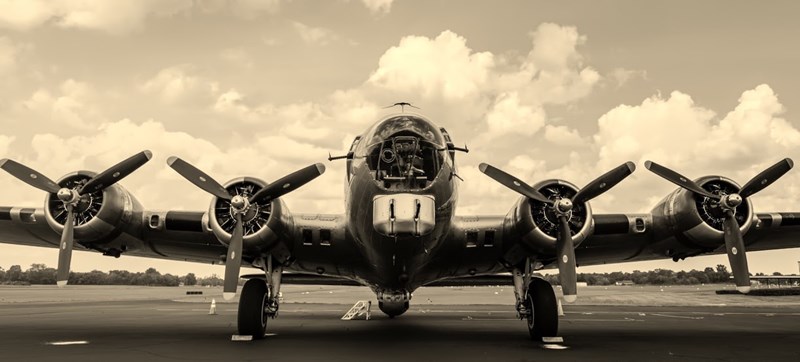
From the October 2012 issue of Chronicles.
He was an all-American boy who became an American hero in World War II. Born in 1920 to a father who, at the age of five, had immigrated to the United States with his family from Sweden and an American-born mother of Irish, Scottish, and English descent, Dick Bong was reared on a farm a few miles west of Poplar and some 15 miles southeast of Superior, Wisconsin. He had eight brothers and sisters. Bong began working in the fields and driving farm machinery at a young age. He stared into the sky at every plane that flew overhead and was enamored of the deeds of Charles Lindbergh, who had grown up just over the state line in Minnesota.
He played on the Superior Central High baseball team with one of my uncles, and hunted and fished. For his 4-H project he planted a windbreak of trees on the family farm. His sister Geraldine, still going strong at 87, told me that he was the best big brother anyone could ask for. In 1938 he began his studies at Superior State Teachers College and enrolled in the Civilian Pilot Training Program. Three years later he enlisted in the Army Air Corps Aviation Cadet Program. Bong excelled in both programs, and, by early January 1942, just a month after the Japanese sneak attack on Pearl Harbor, he had both his wings and a commission as a second lieutenant.
Bong was assigned to the 49th Fighter Squadron at Hamilton Field, located on the shores of San Francisco Bay near the Marin County town of San Rafael. At Hamilton, he was trained in the powerful, twin-engine Lockheed P-38 Lightning, which he would fly throughout the war. Like most fighter pilots, Bong had a wild hair. He got reprimanded by Gen. George Kenney in June 1942 for looping the Golden Gate Bridge, buzzing Market Street in San Francisco, and blowing wash off a clothesline in Oakland. “If you didn’t want to fly down Market Street,” said Kenney, “I wouldn’t have you in my Air Force, but you are not to do it anymore, and I mean what I say.” Kenney later remarked, “We needed kids like this lad.”
By September, Bong was in Darwin, Australia, but was soon moved to a more forward airfield in Port Moresby, New Guinea, which afforded him the opportunity to fly with and learn from decorated aces Charles O’Sullivan and Thomas Lynch. In December Bong got his first aerial victories, shooting down two Japanese fighters during the Battle of Buna-Gona. For his actions he received the first of his many decorations, a Silver Star. He shot down two more Japanese planes on January 7, 1943, and the next day got another to become an ace. During March he got four more kills and was promoted to first lieutenant. In April he downed his tenth Japanese plane to become a double ace and be awarded the Air Medal. He got another in June and then, on July 26, in several minutes of furious action over Lae, he blew four Japanese fighters out of the sky. He was awarded the Army’s second-highest decoration, the Distinguished Service Cross.
By the time he went on leave during the late fall of 1943, Bong had 21 aerial victories and was wearing captain’s bars. Back in Wisconsin, at a Superior State Teachers College homecoming, he met the girl of his dreams, Marge Vattendahl. When he returned to New Guinea in January 1944, he had his ground crew decorate the nose of his P-38 with a large photograph of Marge. It was the last thing seen by many a Japanese pilot. By early April he had added four more kills to his total, and then, on April 12, he shot down three Japanese planes to reach 27 and surpass Eddie Rickenbacker’s World War I record of 26. General Kenney promoted Bong to major and pulled him off the line. Rickenbacker messaged Bong, “Just received the good news that you are the first one to break my record in WWI by bringing down 27 planes in combat, as well as your promotion, so justly deserved. I hasten to offer my sincere congratulations.”
Bong spent the next several months on bond tours in the United States and did not return to the Southwest Pacific until September. He was assigned duty as a gunnery instructor and, although allowed to go on combat missions, ordered not to seek out the enemy. Nonetheless, Bong not only continued to shoot enemy planes out of the sky but did so with his greatest frequency ever. During October, November, and December he got 11 kills, including three in the Battle for Leyte Gulf. On December 12 at Tacloban airfield on Leyte, Gen. Douglas MacArthur awarded Bong the Medal of Honor.
With 40 aerial victories and the MOH, Bong was ordered home. In February 1945 he married Marge in Superior. They honeymooned in California, where Bong undertook a new assignment: as a test pilot for Lockheed. On August 6 he had just lifted off from Lockheed’s Burbank runway in the P-80 Shooting Star jet fighter when a fuel pump malfunctioned. Bong ejected but was too low for his parachute to deploy. The ace of aces was 24 years old.
Leave a Reply